商务英语谈判lecture 1
《商务英语说课》课件

目录
contents
Overview of Business EnglishBusiness English Speaking SkillsAnalysis of Business English Lecture CasesBusiness English Lecture Skills and Strategies
Summary
Summary
Speech Language Standards
Detailed description
This case emphasizes the language norms used in business English srofessional, clear, and persuasive expressions, as well as how to convey information and value through language.
目录
contents
Practice and Improvement of Business English Lecture
01
Overview of Business English
Business English, abbreviated as BE, is a specialized purpose English (ESP) primarily used for communication in business settings and within multinational corporations.
Possible Arguments
Flexibility and Openness to Compile
商务英语谈判情景对话(5篇)

商务英语谈判情景对话(5篇)商务英语谈判篇一Business NegotiationA: The seller Miss su representingKai ya Chocolate Manufacturing Co.LtdB: The buyer Mr.zhou representing zhong shang supermarket.A: Good morning, Mr.Zhou.Glad to meet you.B: Good morning, Miss su.It’s very nice to see you in person.A: How are things going?B: Everything is nice.A: So, what’s the topic of today’s meeting?B: Ok, after the last talk, we appreciate you price very let’s talk about the terms of payment.Would you accept D/P? I hope it will be acceptable to you.A: The terms of payment we usually adopt are sight L/C.B: But I think it would be beneficial to both of us to adopt more flexible payment terms such as D/P term.A: Payment by L/C is our usual practice of doing business with all customers for such commodities.I’m sorry we can’t accept D/P terms.B: As for regular orders in future, couldn’t you agree to D/P?A: Sure.After several smooth transactions, we can try D/P terms.B: Well, as for shipment, the soon the better.A: Yes, shipment is to be made in April, not allowing partial shipment.B: can you make it earlier? May be in March, our customer is eager for them.A: All right.Let me have a check, oh!There are some steam vessels available to your port, so we can make it in March.B: Good!By the way, when can I expect to sign the S/C?A: Mr.Zhou, would it be convenient for you to come again tomorrow morning.I’ll get the S/C ready tomorrow for your signature.B: That’s fine.See you Su.A: See you and thanks for coming, Mr.Zhou.常用商务英语谈判对话开场介绍篇二常用商务英语谈判对话:开场介绍篇编辑:Smart(1)A: I don’t believe we’ve met.B: No, I don’t think we have.A: My name is Chen Sung-lim.B: How do you do? My name is Fred Smith.A: 我们以前没有见过吧?B:我想没有。
商务谈判课件:Chapter 1 negotiation-skills-basics

PEOPLE …..continued
• Emotions
– People get defensive or attack – Emotions effect decision making & judgment – Venting can clear the air – Do not get involved with negative emotional
Basic Principles of Negotiation
Basic Principles of Negotiation
Four Attributes of a Negotiation
Negotiation is based on human needs
what motivates a person? –a need Material needs - want more materialistic things Security Needs - needs for safety and security Psychological needs - mental needs that motivate
• It involves using the art of ‘persuasion’ to get others to understand and agree with your viewpoint. It works best when an individual has a win-win attitude.
Negotiation Skills
商务英语谈判chapter-One--1市公开课获奖课件省名师示范课获奖课件

Stakes
Stakes are the values that may be gained or lost, and costs that may be incurred or avoided.
Disputable interests No free lunch (one for one) Comparison of benefits Current interest vs. long-term interest
白远. 国际商务谈判---理论案例分析与实践. 北京:中国人民大 学出版社,2023. (参照教材)
安排:
1. 教材共七章,每章结束后布置书面作业一份。 2. 每章中小节后旳练习要求学生作为课后练习,自觉完毕。 3. 每位同学准备一种谈判案例并进行技巧分析,在每次上课时
进行课堂演示。
成绩构成
So information is an essential element in the success of negotiation.
Case Two
世界著名旳迪斯尼企业在20世纪90年代遇到这么
一件事情。企业耗资50亿美元在巴黎附近兴建旳主题公
园准备于1992年4月12日开张,工程结束前,建筑承包
Conflict occurs when two or more people compete over limited resources.
What is conflict? What are the features of conflict?
Conflict
A Conflict is a dispute, disagreement or argument between two or more interdependent parties who have different and common interest.
《英语口语课件:商务英语-商务谈判》

商务谈判中的协议书签署
商务谈判成功后,落实协议内容并确保双方共同签署协议书。
商务谈判中的案例分析
通过实际案例,探讨商务谈判的成功和失败因素,以及相关经验教训。
商务谈判中的成功失败案例分 析
分析商务谈判中的成功案例和失败案例,并总结其原因和教训。
商务谈判中的常见错误和解决 方案
总结商务谈判中常见的错误,如缺乏准备、不善于妥协等,并提供解决方案。
商务谈判中的非语言交流
除了语言,非语言交流也是谈判过程中的重要组成部分。包括肢体语言、面 部表情和声音的使用。
商务谈判中的沟通技巧
1 积极倾听
倾听对方的观点,并给予积 极回应。
2 适度提问
通过提问了解对方的需求和 关注点。
3 明确表达
清晰明确地表达自己的意见和要求。
务谈判中的情感控制
掌控情绪
技巧
掌握有效的谈判技巧,如倾听、提问、 换位思考等,有助于更好地达成协议。
商务谈判的基本技巧
目标明确
在谈判前明确自己的目标,以便制定合适的策 略。
有效沟通
善于表达自己的意见,并倾听对方的观点。
灵活应变
在谈判过程中灵活调整策略,适应变化的局势。
建立信任
与对方建立良好的信任关系,有助于达成更好 的合作协议。
保持冷静、沉着,避免情绪化的 反应。
共情
理解对方的观点,并表现出合作 的态度。
沟通技巧
运用积极的沟通技巧来缓解紧张 气氛。
商务谈判中的压力应对
商务谈判常常伴随着各种压力,包括时间压力、目标压力等。有效应对压力, 保持冷静和明智的决策。
商务谈判中的策略分析
制定有效的谈判策略,包括利用信息、研究对手、预测对手反应等。
商务英语谈判和会话unit 1new

• 4. What role does the Guangzhou Fair play in Chinese economy?
The 109th Fair in 2011
• 第一期:2011年10月15日-19日,展出大型机械及设备,小型机械,自
行车,摩托车,汽车配件,化工产品,五金,工具,车辆(户外),工程机械 (户外),家用电器 ,电子消费品,电子电气产品,计算机及通讯产品,照 明产品,建筑及装饰材料,卫浴设备,进口展区等展区。
•
10月20日--22日为换展期。
• 第二期:2011年10月23日-27日,展出餐厨用具,日用陶瓷,工艺陶瓷, 家居装饰品,玻璃工艺品,家具,编织及藤铁工艺品,园林产品,铁石制品 (户外),家居用品,个人护理用具,浴室用品,钟表眼镜,玩具,礼品及赠 品,节日用品等展区。
•
4月28日--4月30日为换展期。
• 在广交会上,美国商人史密斯先生与一位中国的 销售代表王先生在展位前相遇:
and patterns in attending trade fairs. • Know how to introduce a company at a
trade fair. • Know how to introduce products or
services at a trade fair. • Know how to set up business ralationship.
Price
②能够就价格进行谈判
①能够就商品品质、数量、包
8
12
Negotiating on 装、运输、保险、支付等条款 Other Terms 进行谈判
②能够就一般条款进行谈判
谈判教程Lesson 1
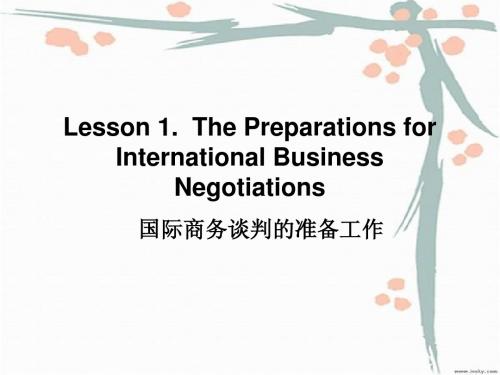
• (3) Choosing the location of negotiation which is favorable to you, for example, choosing the “home court” which is convenient for you to get the information; or at least choosing a neutral location which is equally convenient to both parties. • 选择有利于你的谈判地点,例如,选择主座谈判地点,这 可便于你获得谈判资料,或者至少选择一个对双方都便利 的中间地点。
2. Read and translate the followings into Chinese:
• 1) Negotiation is a dynamic process of adjustment. In import and export trade operations, the buyer and the seller confer together to reach a mutually satisfying agreement on a matter of common interest. This is because each of the parties has his own objective in trade operations, e.g. the seller intends to sell the goods/services at a higher price, while the buyer intends to buy the same goods/ services at a lower price. Each party presses for the attainment of its own goal. But some element of cooperation must be present, otherwise there will be no agreement at all and the opportunity to take part in the activity will be lost.
教学课件 国际商务英语谈判--蒋磊
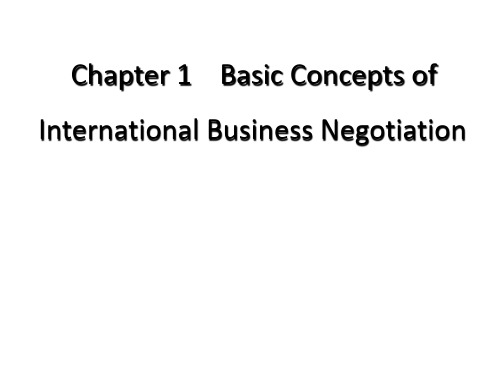
(2)According to the textbook, what is negotiation? In simplest terms, negotiation is a discussion
between two or more disputants who are trying to work out a solution to their problem. Negotiation is a mean of dealing with human relationship and resolving conflicts.
2 negotiation takes place between two or more people;
3 negotiation is used to solve problem or conflicts;
4 people negotiate each other in order to achieve their own aim.
Section Ⅰ
2.The Correct Understanding of Negotiation
(1)What is the conflict of negotiations?
A conflict is a dispute, disagreement or argument between two or more interdependent parties who have different and common interests. A conflict can block each other’s ability to satisfy their interest.
Definition and Characteristics of Business Negotiation
商务英语谈判讲义

How do you deal with others who have more power?
• Never do all or nothing deals • Make the big party small( build multiple
relationships) • make yourself bigger. • build momentum through doing deals in
sequences • Use the power of competition to leverage power • Constrain yourself. • Good information is always a source of power. • Do what you can to manage the process
Main parts
A Definition of Power Why Is Power Important to Negotiators? Sources of Power—Acquire Power Dealing with Others Who Have More
power ? How to Conceptualize Culture? The Influence of Culture on Negotiation Advice about how to negotiation cross-
Advice about how to negotiation cross-culturally
Their own biases, strengths and weaknesses
The other negotiator as an individual
国际商务谈判(英文) 全套课件
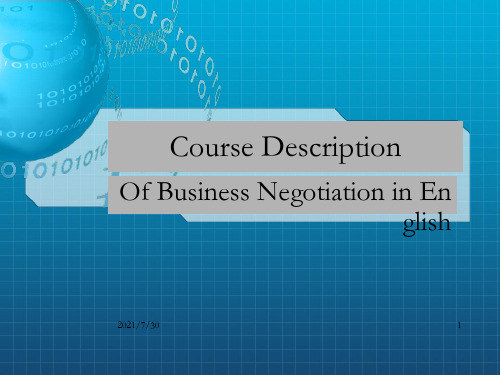
• Pear Case • House Rent
Leading-in Examples
3
1. Three Questions Course Introduction
1) What is (business) negotiation? 2) What is the purpose of (business) negotiation? 3) By what means can we win the negotiation? Or What skills are revolved in a successful negotiatio
5
2.The three features of negotiation:
• contradiction co-operation concession • 1) Two parties in contradiction try to reach an agreement on c
ooperation through discussion and concessions. • 2) The general purpose is cooperation. The concrete purpose is
n? And What are the proper English expressions being used?
4
The Answers to the First Questio n
• The business negotiations ar e tough talks happening bet ween two parties in contradi ction for the purpose of coo peration and making maxim um benefit through discussi on and concessions
国际商务英语谈判串讲
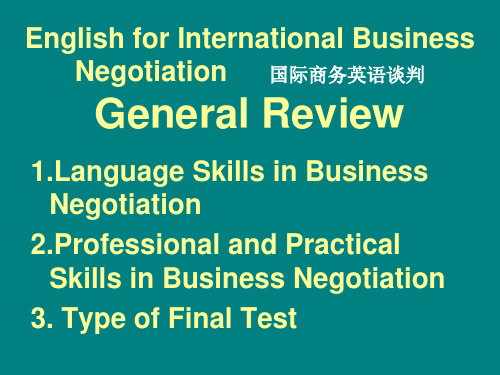
Business negotiations proceed through four stages: a) non-task sounding (开局前的试探) b) task-related exchange of information (交换
There are four main phases of negotiation listed below: 1) The preparing phase (预备阶段) 2) The debating phase (争论阶段) 3) The proposal phase (建议阶段) 4) the bargaining phase(讨价还价阶段)
Manner Direct Manner Decision-Making Quick, Top-Down Work Ethic Individual Oriented
Value Results more than its Process Efficiency, Competition in Workers Frustrating Workers
2.2.1 Links of International Business Negotiation
• Generally speaking, to reach an agreement in the international business negotiation needs going through five links :
2. Professional Skills in Business Negotiation
Please focus on: 2.1 Links of International Business Negotiation 2.2 Incoterms® 2010 2.3 Payment of International Business 2.4 Contract of International Business
商务英语谈判unit 1 Negotiation Preparations

Unit 1 Negotiation Preparations
I. Warm Up
Work in pairs with the following situation
You are a clerk in a research firm, and now you are demonstrating your research report, which has included some of the preliminary findings, to your customer. He is very satisfied with what you have done. Then you discuss a plan for the next step.
Unit 1 NΒιβλιοθήκη gotiation Preparations
IV. Keys to Exercises
1. Translate the following sentences into Chinese
1. One of the purposes of market research is to find out whether there's a market for the product. 市场调研的目的之一就是了解这种产品是否有市场。
2. Sometimes the companies do their own market research, and sometimes they employ specialists to do it. 有时候公司自己搞调研,有时请专家做调研。
Unit 1 Negotiation Preparations
Chapter1BusinessNegotiation商务谈判

Chapter 1 Business Negotiation
1.Some Basic Concepts of Negotiation
(1)The Concept of Negotiation A negotiation is a process of communication between parties
• 2.The Forms of Business Negotiation
Chapter 1 Business Negotiation
3.The Overall Framework of International Business Negotiation
Background Atmosphere Factors
1)the best target; 2)the intermediate target; 3)the acceptable target.
Chapter 1 Business Negotiation
• 5.Basic Rules of International Business Negotiation
• 1.Some Basic Conceots of Negotiation • 2.The Forms of Business Negotiation • 3.The Overall Framework of International Business
Negotiation • 4.Features of International Business Negotiation • 5.Basic Rules of International Business Negotiation • 6.The General Producer of International Negotiation • munication Skills for Negotiations • 8.Types of Negotiation Styles • 9.The Business Contract
《商务英语谈判》课件

掌握有效的提议和反驳技巧,以实现自己的谈判目标。
谈判案例分析
1
成功的谈判案例
分析一些成功的商务谈判案例,探讨其
失败的谈判案例
2
背后的关键因素和策略。
研究一些谈判失败的案例,探寻失败的
原因,以免犯同样的错误。
3
成功和失败的原因
对成功和失败的商务谈判案例进行分析, 研究造成不同结果的原因。
《商务英语谈判》PPT课 件
在本课件中,我们将学习商务英语谈判的重要性和特点,探讨准备阶段的步 骤,研究谈判技巧和案例分析,以及提高谈判效果的方法。
背景介绍
商务谈判在商业领域扮演着重要的角色,本节将介绍商务英语谈判的特点以 及其在商业谈判中的重要性。
准备阶段
初步调研
在谈判开始之前,进行充分的初步调研,了解对方和其业务,为谈判做好准备。
提高谈判效果的方法
有效的沟通技巧
学习如何与对方建立良好的沟 通,以实现更有效的谈判结果。
良好的人际关系建立
了解如何在商务谈判中建立良 好的人际关系,以增加合作的 机会。
软实力的应用
掌握利用软实力的方法,如影 响力和说服力,以在谈判中取 得更好的结果。
谈判目标的设定
明确自己的谈判目标,并制定清晰的目标和策略,以实现自己的利益。
谈判策略的制定
根据对方的需求和目标,制定适合的谈判策略,以达成双方的共赢。
谈判技巧
1 听和问的技巧
学习有效的倾听和提问技巧,以更好地理解和掌握息,以增强自己在谈判中的优势。
商务英语谈判
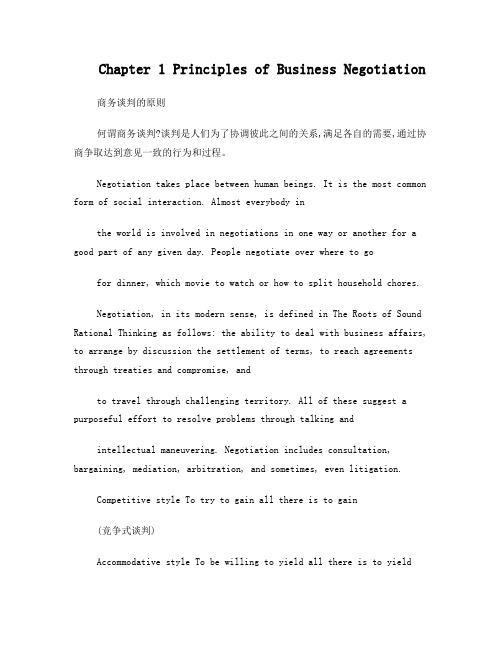
Chapter 1 Principles of Business Negotiation商务谈判的原则何谓商务谈判?谈判是人们为了协调彼此之间的关系,满足各自的需要,通过协商争取达到意见一致的行为和过程。
Negotiation takes place between human beings. It is the most common form of social interaction. Almost everybody inthe world is involved in negotiations in one way or another for a good part of any given day. People negotiate over where to gofor dinner, which movie to watch or how to split household chores.Negotiation, in its modern sense, is defined in The Roots of Sound Rational Thinking as follows: the ability to deal with business affairs, to arrange by discussion the settlement of terms, to reach agreements through treaties and compromise, andto travel through challenging territory. All of these suggest a purposeful effort to resolve problems through talking andintellectual maneuvering. Negotiation includes consultation, bargaining, mediation, arbitration, and sometimes, even litigation.Competitive style To try to gain all there is to gain(竞争式谈判)Accommodative style To be willing to yield all there is to yield(通融式谈判)Avoidance style To try to stay out of negotiation(回避式谈判)Compromising style To try to split the difference or find (妥协式谈判) an intermediate point according tosome principleCollaborative style To try to find the maximum possible (合作式谈判) gain forboth parties----by carefulexploration of the interests of allparties----and often by enlarging the pieVengeful style To try to harm the other(报复式谈判)Self-inflicting style To act so as to harm oneself(自损式谈判)Vengeful and self-inflicting style To try to harm the other andalso(报复和自损式谈判) oneselfPeople who go for the competitive style are known as hard-bargaining negotiators. They start off with outrageous demands, using threats and other tactics to get what they want. One side typically starts out high and the other low. Afterseveral rounds of offer and counter-offer, the negotiators end up “spl itting the difference”. In this form, negotiation is viewed asa game where each side tries to get the best deal for themselves. Neither side exhibits concern for the other side.1.1Principle of Collaborative Negotiation合作式谈判的原则Ⅰ. Collaborative NegotiationNegotiation can also assume the form of collaborative style. It involves people with diverse interests working togetherto achieve mutually satisfying outcomes. Collaborative negotiation is known by many names. Some popular names include “problem-solving negotiation”, “consensus-building negotiation”, “interest-based negotiatio n”, “win-win negotiation”, “mutualgains negotiation”, and so on.The goal of collaborative negotiation is to manage the dispute so that the outcome is more constructive than destructive. A destructive outcome results in damages and involves exploitation and coercion. Aconstructive outcome fosters communication, problem-solving, andimproved relationships.● The negotiation parties have both diverse and common interests.● The common interests are valued and sought.● The negotiation process can result in both parties gaining something.● The negotiating arena is controlled by enlightened self-interest.● Interdependence is recognized and enhanced.● Limited resources do exist, but they can usually be expanded through cooperation and creativity.● The goal is a mutually agreeable solution that is fair to all parties and effective for the community/group.The collaborative negotiation focuses on interests rather positions. Integrative solutions are obtained by understandingother’s self-interests, not by jostling for positions.The collaborative negotiation places value on relationship. It requires trust and relies on full disclosure of relevant information.The disadvantages of this approach are:●It may pressure an individual to c ompromise and accommodate inways not in his best interest.●It avoids confrontational strategies, which can be helpful at times.●It increases vulnerability to deception and manipulation by a competitive opponent.●It makes it hard to establish defi nite aspiration levels and bottom lines.●It requires substantial skill and knowledge of the process.●It requires strong confidence in one’s perceptions regarding the interests and needs of the other side.Ⅱ. Principled NegotiationIn this form, each side of the negotiating parties attempt to meet the other side’s interest as well as their own. By thoroughly understanding their own interest as well as the other’s, both sides are often able to arrive at solutions neither alone could have envisioned or made possible. In this type of negotiation, each side recognizes and accepts the legitimate interests of the other side and they are committed to dealing with differences constructively in order to advance their own self-interests. This has been called “collaborativeprincipled negotiation”, a concept set forth by Roger Fisher and William Ury in their book Getting to Yes: Negotiating Agreement Without Giving In.Principled negotiation is particularly oriented to collaborative negotiations. However, it can be used in competitive negotiations and inother aspects of conflict management. It is a method that is centered around four considerations (PIOC):● People: Separate the people from the problem.● Interests: Focus on interests, not positions (inte rests always underlie positions).● Options: Invent options for mutual gains.● Insist on using objective criteria.1.Separate the people from the problemFisher and Ury pointed out that “negotiators are people first”. There are always relational and substantive issues in negotiation. The relational issue tends to become entangled with the problem and the positional bargaining puts relational and substantive issues in conflict with each other. Fisher and Ury suggested that the negotiators separate the relationship from the substance and deal directly with the people problem.It is a feasible to deal with a substantive problem and maintain a good working relationship between negotiating parties. People problems are usually caused by inaccurate perception, inappropriate emotions and poor communication. In order to deal with those problems, three techniques are recommended for both parties to follow:A.Establish an accurate perception.●Conflict, very often, is not caused by what happens, but by ho w people perceive what happens.●Increase the capability of each party to see the other side’s point of view (for example, by reversing roles).●Avoid blaming the other party for your problems.●Discuss each other’s perceptions of the problem.●Get the other party to participate in the mutual activities.●Seek to make negotiation proposals consistent with the other party’s values.B.Cultivate appropriate emotion.●Your emotion affects that of the other party.●Recognize and understand emotio ns of both parties.●Make emotions explicit and legitimate.●Allow the other party to let off steam.●Stay calm with the other party’s emotional outbursts.C. Strive for better communication.● Negotiation is a process of communicating between pa rties for the purpose of reaching a joint decision.● Be an active listener and acknowledge what is being said.● Speak to be understood.● Avoid criticism that may hurt the other party’s feelings.● Speak for a purpose.2. Focus on interests, not positionsIn such a case, negotiators need to distinguish between interests and positions and focus on interests not positions. A position is what you want or must have. An interest is why you want what you want.Positions can be thought of as a one-dimensional point in a spaceof infinite possible solutions. Positions are symbolic representations of a participant’s underlying motivating interests. In negotiation, there are many kinds of interests: multiple interests, shared interests, compatible interests and conflicting interests. Indentifying shared and compatible interests as “common ground” can be helpful in establishing a found for additional discussions. “Easy points of agreement”can be indentified and the principles underlying those easy points of agreement can often be extrapolated to help resolve other issues. Methods for focusing on interests instead of positions are as follows:A. Identify the self-interests.● Explore and recognize the interests of the other party that stand in your way.● Examine the different interests of different people on the other side.● Respect your counterparty as human beings and recognize the needs and interests that underlie their positions.B. Discuss interests with the other party.●Give your int erests a vivid description. Be specific.●Demonstrate your understanding of the other party’s interests and acknowledge them as part of the overall problemthat you are trying to solve.●Discuss the problems before proposing a solution.●Direct the discussion to the present and the future. Stay away from the difficulties of the past.●Be hard on the problem but soft on the people.3.Invent options for mutual gainsHere are the steps for overcoming the obstacles and developing multiple solution options:A.Separate the act of inventing options from the act of judging them.●Run a brainstorming session.☆Before brainstorming:■Define your propose----what you would like to achieve at meeting.■Choose a few participant (between five and ei ght people)■Change the environment----select a time and place distinguishing the session from regular discussions.■Design an informal atmosphere----talking over a drink, meeting at a vacation lodge or any other forms that make participants feel relaxed.■Choose a facilitator----a facilitator is needed to keep the meeting on track, make sure everyone gets a chance to speak, and stimulate discussion by asking questions.☆During brainstorming:■Seat the participants side by side facing the problem.■Clarify the ground rules, including the no-criticism rule.■Brainstorm.■Record the idea in full view.☆After brainstorm:■Check the most promising ideas----mark those ideas that participants think are the best.■Explore improvements for prom ising ideas----take one promising idea and explore ways to make it better and practical.■Set up a time to evaluate ideas and make a decision.●Consider brainstorming with the other side; it can be very valuable.B.Develop as many options as possible before choosing one.●Adopt the four types of thinking in generating options.●Look at the problem through the eyes of different experts.●Develop different versions of agreement.●Change the scope of a proposed agreement----break the problem into smaller units.C.Search for mutual gains.●Identify shared interests.●Dovetail differing interests.4.Insist on using objective criteriaThe guidelines for objective criteria are:●Independent of wills of all parties.●Legitimate and practi cal.●Acceptable to all parties.After identifying objective criteria and procedures, it is time to discuss them with the other party. There are three basic points to remember:A.Frame each issue as a joint search for objective criteria.B.Reason and be open to reason as to which standards are most appropriate and how they should be applied.C.Never yield to pressure, only to principle----yield to an argument or presentation that is based on reason and principle,not to one based on pressure.1.2Principle of Interest Distribution利益分配原则In negotiations at the domestic level, there are two types of interests involved: personal and organizational; at the international level, there are three: personal, organizational and national.Organizational RolesPrinciples and Agents1.3Principle of Trust in Negotiation信任的原则Trust is something of great importance in negotiation. Professor Richard C. Reuben defined it as “a state involving expectations about another’s motives and actions with re spect to oneself in situations entailing risk of uncertainty”. In the outline of his Negotiation----Law 5810, he states that there are three types of trust in professional relationships:●Deterrence-based trust (威慑型信任)☆ Calculus-based trust (预计型信任)●Knowledge-based trust (了解型信任)●Identification-based trust (识别型信任)Ⅰ. Trust Building in Negotiation1.Speak their language2.Manage your reputation3.Make dependence a factor4.Make unilateral concessions your concessions6.Explain your demandsIn their book entitled The Only Negotiating Guide You Will Ever Need, Peter B. Stark and Jane Flaherty list fifteen things that a negotiator can do to build trust with his counterpart.1.Demonstrate your competence2.Make sure the nonverbal signals you are sending match the words you are saying3.Maintain a professional appearancemunicate your good intentions5.Do what you say you are going to do6.Go beyond the conventional relationship7.Listen8.Over-communicate9.Discuss the indiscussibles10.Provide accurate information, without any hidden agenda11.Be honest----even when it costs you something12.Be patient13.Uphold fairness14.Negotiate for abundance, not scarcity15.Take calculated risksⅡ. Maximiz ing Joint Gain1.4Principle of Distributive, Integrative & Complex Negotiation两分法谈判、双赢谈判和复杂谈判的原则Ⅰ. Distributive NegotiationJennifer E. Beer listed a set of distributive bargaining strategies in Culture at work:1.Preparation2.Opening offers3.Exchange information and arguments4.Concessions and decisionsⅡ. Integrative Negotiation。
商务英语谈判lecture 1

Steps for overcoming the obstacles
A. Separating the act of inventing options from the act of judging them. Run a brainstorming session:
Before brainstorming:
商务英语谈判lecture1ppt道客巴巴
Business Negotiation English
Objectives
1. Introduce the students to the main principles of business negotiation. 2. The students get familiar with the types of negotiation. 3. A detailed study of one negotiation method---principled negotiation. 4.Case Study 5.Simulated negotiations
The assumptions :
The negotiation parties have both diverse and common interests The common interests are valued and sought. The negotiation processes can result in both parties gaining something. The negotiating arena is controlled by enlightened selfinterest. Interdependence is recognized and enhanced. Limited resources do exist, but they can usually be expanded through cooperation and creativity. The goal is a mutually agreeable solution that is fair to all parties and effective for the community / group.
商务英语谈判和会话unit1new

Questions that suggest an answer or bias the response in a specific direction
Perception skills
Logical arguments
Presenting facts, statistics, and evidence to support one's position
Negotiating differences
Resolving differences and negotiating solutions to problems
Phase of achieving an agreement
Summarizing the negotiation results
Summarizing the main points of the negotiation and highlighting the key issues
Start stage
Greeting and introduction
01
Expressing greetings and introducing one self
and the other party
Outlining the negotiation agenda
02
Briefly introducing the topics and objectives of
Open and Honey Communication
Use open and honey language to discover your ideas and positions, while examining the other party's views
- 1、下载文档前请自行甄别文档内容的完整性,平台不提供额外的编辑、内容补充、找答案等附加服务。
- 2、"仅部分预览"的文档,不可在线预览部分如存在完整性等问题,可反馈申请退款(可完整预览的文档不适用该条件!)。
- 3、如文档侵犯您的权益,请联系客服反馈,我们会尽快为您处理(人工客服工作时间:9:00-18:30)。
3. Types of negotiation:
1. Competitive style: To try to gain all there is to gain. 2. Accommodative style: To be willing to yield all there is to yield. 3. Avoidance style: To try to stay out of negotiation.
Definitions:
----the ability to deal with business affairs, ----to arrange by discussion the settlement of the terms, ----to reach agreements through treaties and compromise, ----to travel through challenging territory. consultation,bargaining, mediation, arbitration, and litigation
Types of negotiation:
4. Compromising style: To try to split the difference or find an intermediate point according to some principle. 5. Collaborative style: To try to find the maximum possible gain for both parties----by careful exploration of the interests of all parties-----and often by enlarging the pie.
Disadvantages :
Pressure an individual to compromise and accommodate in ways not in his interest. Avoid confrontational strategies, which can be helpful at times. Increase vulnerability to deception and manipulation by a competitive opponent. Make it hard to establish definite aspiration levels andntial skill and knowledge of the process. Require strong confidence in one ‘s perceptions regarding the interests and needs of the other side.
---Define your purpose: what you would like to achieve at the meeting. ---Choose a few participants: 5-8 people. ---Change the environment: distinguishing the session from regular discussion. ---Design an informal atmosphere: a drink, at a vacation lodge etc. ---Choose a facilitator: to keep the meeting on track.
Chapter 1
Principles of Business Negotiation: 1. What is negotiation? ----the process we use to satisfy our needs when someone else controls what we want. (Robert Maddux) ----Whenever people exchange ideas with the intention of changing relationships, whenever they confer for agreement, then they are negotiating. (Gerard I. Nierenberg)
Practice: Please check off the following situations that represent negotiations.
1. Purchasing a computer at a department store. 2. Deciding with the family where to go for the weekend. 3. Bidding for a second-handed car. 4. Deciding how the house will be cleaned up. 5. Borrowing a musical instrument from a friend. 6. Selecting a contractor to build a new kitchen. 7. Deciding whether to stay late at work to finish up a project.
Types of negotiation:
6.Vengeful style : To try to harm the other. 7. Self-inflicting style: To act so as to harm oneself. 8. Vengeful and self-inflicting style: To try to harm the other and also oneself.
Business Negotiation English
Objectives
1. Introduce the students to the main principles of business negotiation. 2. The students get familiar with the types of negotiation. 3. A detailed study of one negotiation method---principled negotiation. 4.Case Study 5.Simulated negotiations
*Separate the people from the problem.
Techniques: ---Establish an accurate perception. ---Cultivate appropriate emotions. ---Strive better communication.
4. Principle of Collaborative negotiation
Problem-solving negotiation Consensus-building negotiation Interest-based negotiation Win-win negotiation Mutual gains negotiation, etc.
5. Principled Collaborative Negotiation
PIOC: People: Separate the people from the problem. Interests: Focus on interests, not positions (interests always underlie positions) Options: Invent options for mutual gains. Criteria: Insist on using objective criteria.
During brainstorming:
---Seat the participants side by side facing the problem; ---Clarify the ground rules, including the no-criticism rule; ---Brainstorm; --- Record the ideas in full view.
The assumptions :
The negotiation parties have both diverse and common interests The common interests are valued and sought. The negotiation processes can result in both parties gaining something. The negotiating arena is controlled by enlightened selfinterest. Interdependence is recognized and enhanced. Limited resources do exist, but they can usually be expanded through cooperation and creativity. The goal is a mutually agreeable solution that is fair to all parties and effective for the community / group.
2. When do people negotiate?
---where to go for dinner ---which movie to watch ---how to split household chores, etc ---whether to buy a computer ---who to have the first apple
